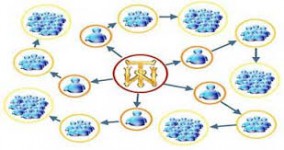پیشینه زنجیره تامین پایدار در صنعت فرش ماشینی ایران
منابع:
1. بابایی، محمدرضا.، سیداصفهانی، یرمهدي.، میرزایی، رید. (1386). اثرات عوامل ایجادکننده عدم اطمینان برزنجیره تامین در صنایع فرش ماشینی کشور. ششمین کنفرانس ملی مهندسی نساجی ایران.
2. خاکی، غلامرضا. (1382). روش تحقیق با رویکردي به پایان نامه نویسی. انتشارات: بازتاب.
3. سرمد، زهره.، بازرگان، عباس.، و حجازي، الهه. (1381). روشهاي تحقیق در علوم رفتاري. تهران: نشر آگه.
4. شفیعی نیک آبادي، محسن. (1390). ارائه مدلی جهت بررسی رابطه فرآیندهاي مدیریت دانش بر عملکرد زنجیره تأمین. رساله دکتري. دانشگاه علامه طباطبایی.
5. عزتی، مرتضی. (1376). روش تحقیق در علوم اجتماعی: کاربرد در زمینه مسایل اقتصادي. انتشارات: دانشگاه تربیت مدرس.
6. کمیسیون استاندارد ویژگی هاي فرش ماشینی تک ماکوئی اکریلیک. (1377). ویژگی هاي فرش ماشینی تک ماکوئی اکریلیک، چاپ سوم، موسسه استاندارد و تحقیقات صنعتی ایران.
7. کیوي، ریمون، کامپنهود، لوك وان. (1381). روش تحقیق در علوم اجتماعی، ترجمه عبدالحسین نیک گهر ،
تهران: توتیا.
8. مؤمنی، منصور. (1386). تحلیل هاي آماري با استفاده از SPSS. تهران: انتشارات کتاب نو.
9. نادري، عزت اﷲ، مریم سیف نراقی و فرنگیس شاهپوریان. (1376). راهنماي عملی فراهم سازي طرح تحقیق.
تهران: انتشارات بدر.
10. نساج، احسان. (1392). بررسی عمومی صنعت فرش ماشینی ایران. مجله نساجی کهن، اسفند.
11. Adetayo J.O, Sanni S.A and Ilori M.O (1999). The impact of information technology on product marketing: a case study of a multinational company in Nigeria. Technovation 19, 691–699.
12. Akkermans Henk, Bogerd Paul and van Doremalen Jan (2004). Travail, transparency and trust: A case study of computer-supported collaborative supply chain planning in high-tech electronics. European Journal of Operational Research 153, 445–456
13. Al-Odeh, Mahmoud., & Smallwood, Jim. (2012). Sustainable Supply Chain Management: Literature Review,Trends, and Framework. International Journal of Computational Engineering & Management, Vol. 15 Issue 1
14. Angerhofer, B.J., Angelides M.C. (2006). A model and a performance measurement system for collaborative supply chains. Decision Support Systems, 42, 283– 301.
15. Azapagic, A . (2004). Developing a framework for sustainable development indicators for the mining and minerals industry. Journal of Cleaner Production 12, 639–6 62.
16. Azorın, Jose F. Molina, Et Al. (2009). Environmental Practices And firm Performance: An Empirical Analysis In The Spanish Hotel Industry. Journal Of Cleaner Production, 17, 516– 524
17. Barnett, M.L. (2007). Stakeholder Influence Capacity And The Variability Of financial Returns To Corporate Social Responsibility. Academy Of Management Review, Vol. 32 No. 3, Pp. 794-816.
18. Barratt, M. (2004a). Understanding the meaning of collaboration i n the supply chain. Supply Chain Management : An International Journal , Vo l. 9 No. 1, pp. 30-43.
19. Barratt, M. (2004b). Unveiling enabler s and inhibitor s of collaborative planning. International Journal of Logistics Management, Vol. 15 No. 1, pp. 73-91.
20. Bassioni H.A, Hassan T.M and Price A.D.F (2007). Evaluation and analysis of criteria and sub-criteria of a construction excellence model. Engineering, Construction and Architectural Management Vol. 15 No. 1, pp. 21-41.
21. Bastianoni, S., Nielsen, SN., Marchettini, N., & Jorgensen, SE. (2005). Use of thermodynamic functions for expressing some relevant aspects of sustainability. Int J Energy Res, 29: 53–64.
22. Basurko, O.C.,, Mesbahi, E. (2012). Methodology for the sustainability assessment of marine technologies. Journal of Cleaner Production, 1-10
23. Beach R, Webster M and Campbell K.M (2005). An evaluation of partnership development in the construction industry. International Journal of Project Management Vol. 23 No. 8, pp. 611-21.
24. Beamon BM (1999a) .Measuring supply chain performance. International Journal of Operations & Production Management Vol. 19 No. 3, pp. 275-292.
25. Beamon BM (1999b). Designing the green supply chain. Logistics Information Management 12(4):332–42.
26. Bebbington, J. (2007). Accounting for sustainable development performance. London: Elsevier.
27. Bhagwat, R., & Sharma, M. K. (2007). Performance measurement of supply chain management: A balanced scorecard approach. Computers & Industrial Engineering, 53 (1), 43–62.
28. Bigliardi, Barbar., Bottani, Eleonora. (2010). Performance measurement in the food supply chain: a balanced scorecard approach. Facilities, Vol. 28 No. 5/6, pp. 249-260
29. Blackhurst J.V, Scheibe K.P and Johnson D.J (2008). Supplier risk assessment and monitoring for the automotive industry. International Journal of Physical Distribution & Logistics Management Vol. 38 No. 2, pp. 143-165.
30. Bolstorff, P. (2003). Measuring the impact of supply chain performance. CLO/ Chief Logistics Of ficers, vol. 12, pp. 5– 11 .
31. Bovea, M.D., & Vidal, R. (2004). Increasing product value by integrating environmental impact, costs and customer valuation. Resources, Conservation and Recycling, 41, 133–145.
32. Brammer, S. And Millington, A. (2008). Does It Pay To Be Different? An Analysis Of The Relationship Between Corporate Social And financial Performance. Strategic Management Journal, Vol. 29 No. 12, Pp. 1325-1343.
33. Brewer, P. and Speh, T. (2000). Using the balanced scorecard to measure supply chain performance. Journal of Business Logistics, Vol. 21 No. 1, pp. 75-93.
34. Brinkerhoff J. M (2002). Assessing and improving partnership relationships and outcomes: a proposed framework. Evaluation and Program Planning Vol. 25 No. 3, pp. 215-31.
35. Brown G.W and Khoker Z (2007). Corporate risk management and speculative motives. Journal of Risk Vol. 10 No. 2, pp. 1-30.
36. Büyüközkan, Gülçin., dem Berkol, Çig. (2011). Designing a sustainable supply chain using an integrated analytic network: process and goal programming approach in quality function deployment. Expert Systems with Applications. In the press.













